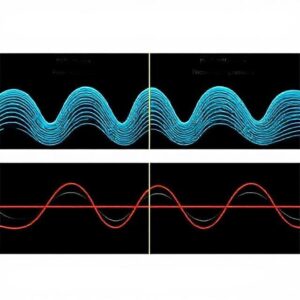1. Phase Difference:
Phase difference refers to the difference in the phase of two waves at a specific point in space and time. When two waves of the same frequency are traveling together, they can either be in sync or out of sync with each other. The phase difference tells us how much one wave is ahead or behind the other in terms of its cycle.

What does Phase Difference mean?
- Phase of a wave refers to its position in its cycle at a specific time. If you think of a wave as a moving up and down line (like ocean waves), the phase would tell you if the wave is at its highest point (crest), lowest point (trough), or somewhere in between.
- When two waves are perfectly aligned in their motion, they have zero phase difference.
- If one wave reaches its crest before the other, they have a non-zero phase difference.
How is Phase Difference Measured?
The phase difference is typically measured in radians or degrees.
- A phase difference of 0° or 0 radians means the waves are perfectly in sync (called in phase).
- A phase difference of 180° or π radians means the waves are completely out of sync (called out of phase).
Example:
- Imagine two sound waves. If one sound wave reaches its maximum displacement (crest) when the other wave reaches its minimum displacement (trough), they are said to have a phase difference of 180° or π radians. This means they are out of phase and can cancel each other out if combined (called destructive interference).
- If both waves reach their crests and troughs at the same time, their phase difference is 0°, and they will reinforce each other (called constructive interference).
Phase Difference Formula:
Phase difference (Δϕ) between two waves can be calculated using the formula:
Where:
- Δϕ is the phase difference in radians.
- Δx is the distance between the two waves at a specific point.
- λ is the wavelength of the waves.
2. Path Difference:
Path difference refers to the difference in the distance traveled by two waves from their respective sources to a particular point. In simple terms, it’s the difference in the distances that two waves travel to meet at a specific point.
What does Path Difference mean?
- Imagine two waves traveling from two different points toward a single point. The path difference tells you how far apart the waves are when they arrive at that point.
- If two waves travel the same distance, the path difference is zero. If one wave has to travel a longer distance, there will be a path difference.
How is Path Difference Measured?
The path difference is measured in meters (m) or wavelengths (λ). The key idea is that the interference between the two waves depends on their path difference:
- If the path difference is an integer multiple of the wavelength (like λ, 2λ, 3λ, etc.), the waves will be in phase and will reinforce each other (constructive interference).
- If the path difference is an odd multiple of half the wavelength (like λ/2, 3λ/2, etc.), the waves will be out of phase and will cancel each other out (destructive interference).
Example:
- If two waves have a path difference of λ (one full wavelength), they will meet in phase and amplify each other (constructive interference).
- If the path difference is λ/2 (half a wavelength), they will be out of phase and cancel each other out (destructive interference).
Path Difference Formula:
The path difference (Δx) between two waves can be related to the phase difference (Δϕ) using this formula:
Where:
- Δx is the path difference (in meters).
- Δϕ is the phase difference (in radians).
- λ is the wavelength of the waves.
Key Differences Between Phase Difference and Path Difference:
- Phase Difference:
- Refers to the difference in the phase (or position) of two waves at a particular point.
- Measured in radians or degrees.
- It tells you how much one wave is ahead or behind another in its cycle.
- Path Difference:
- Refers to the difference in the distances traveled by two waves from their sources to a particular point.
- Measured in meters or wavelengths.
- It determines whether the waves will interfere constructively or destructively.
In Summary:
- Phase Difference tells you how much one wave is ahead or behind another in its cycle.
- Path Difference tells you how far apart two waves are at a specific point in space.
- The path difference can result in constructive or destructive interference, depending on whether it’s a multiple of the wavelength or not.
- The phase difference is related to how in-sync or out-of-sync the waves are with each other.
Both concepts are important when studying wave interference, like in light waves (creating patterns of bright and dark spots), sound waves, and even water waves.
Tags: 180° phase difference, amplitude reinforcement, cancellation, coherent waves, constructive interference, crest, degrees, destructive interference, diffraction, distance difference, energy transfer, half wavelength, in-phase, integer multiples, intensity patterns, interference conditions, interference pattern, Light Waves, optical path difference, Oscillation, out-of-phase, path difference, phase angle, Phase Difference, Phase Shift, physical path, radians, radiation pattern, resonance effects, sinusoidal waves, Sound Waves, trough, wave alignment, wave behavior, wave cycle, Wave Equation, wave interference, wave motion, wave phase position, wave physics., wave superposition, wave synchronization, wave travel, wavefronts, wavelength (λ), zero phase difference, Δx, Δϕ, π radians


